Sea Lions-Remarkables-Platypus (third try)
Kangaroo Island is famous for its wildlife, and what a day this turned out to be. But first stop: the grocery. Bread, cheese, (ripe!) avocados, cherry tomatoes, german sausage, pickled onions, rum and raisin chocolate, trail mix, smoked fish, more pickles, and a bottle of rum.
Once on the road, we take to the dirt options like ducks to water, though heeding the rental guys request/instruction not to use one particular road (which, naturally would have been the most direct route to where we wanted to go). But serendipity as always working in our favor, the alternative takes us passed the Emu Ridge Eucalyptus Distillery.
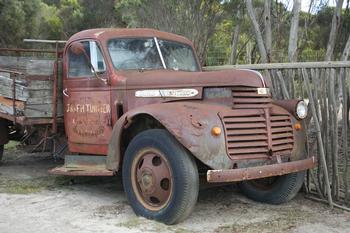 |
How could you not stop? The word "distillery" alone pulled the car off the road. The only disappointment is that they are not making liquor, though after brief reflection, not being obliged to taste something that smells like rubbing alcohol brings a certain sense of relief. The battered old shed that is the store is, however, home to just about everything else you could imagine, both emu- and eucalyptus-wise. Soaps, lotions, oils, eggs, skins, post cards, and so on and so on. You can even sit in an old buggy and watch a video on eucalyptus distillation. We did. |
 |
It seemed a little odd that there were two or three folks working the store, with so little to do that one gave us a personal walk through the entire product range. Then the light dawned. An enormous Sea Link bus crawled into the parking lot and disgorged a hopeful of people at the door. "Right on time" says our hostess, glancing at her watch. We made our purchases hastily, and beat a quick retreat.
Okay it is not exactly wild, but it is the name of the joint, and I did buy one of her eggs. We do need to spot them in the wild too though. |
 |
These guys are actually at work distilling eucalyptus. The smoke stack is from the still, the steam is from the cauldron. You can't see the several cubic yards of leaves the driver is about to drop into the boiling water. |
 |
No idea what this vehicle does, or did, though it looks like some sort of shredder with that hopper on the back. Likewise the building/artwork behind it may or may not still serve some useful purpose. Both these shots were taken from the road, not ten seconds after we left the distillery. |
| We've only gone another couple of hundred yards when we stop again, this time to admire these yuccas and the Rainbow Lorikeets feeding on the flowers (that's the spike). Notice the black "trunks" of the plant. A minivan of tourists pull up next to us and the guide explains to his entourage that the yuccas only flower about once in very hundred years, not least because they have to burn in order to trigger the flowering cycle. |
|
Next stop: Bald Hill, Murray Lagoon, Cape Gantheaume Conservation Park, Timber Creek Walk. Take your pick, they all seem to be the same place. We stop to give directions to a car-full of people who, incredibly, appear to have ventured out without a map. Less incredibly they are from New Jersey. Timber Creek walk is an unassuming, straight, flat run out to the lagoon. But we're fighting birds off with a stick. Or at least I am. Wayne's simply moving at a snail's pace. When we finally make it as far as the lagoon (half a mile at the most) there's a platform on a small rise that provides a commanding view. I guess we're on the side of Bald Hill, though it is more of a ripple than a hill. Wayne points the spotting scope at a line of brush sticking out of the water about 200 yards from the shore. It takes him about 30 minutes to inch along it, recording the abundant life it is apparently harboring. I'm able to identify what we've come to know as "schwartzer schwanstückers" patrolling the open water but that's it. (For some reason, common as they are, neither of us gets a good shot of these majestic birds. It's not as if they are not a big enough target.)
|
 |
 |
|
Seal Bay is home to one of the country's largest
colonies of Australian sea lions, which over time have become surprisingly
tolerant of the almost constant stream of excited tourists. Supervised tours run
by the NPWS allow visitors to get astonishingly close to these beautiful animals,
who will be either lazing about on the beach or playing in the surf. Tours are
conducted every 45 min throughout the day, kicking off as early as 9:00 in the morning.
Another 17km W of the Kelly Hill Caves, the scenic South Coast Road comes to
a fitting end amidst the splendor of the must see Flinders Chase NP.
Encompassing the entire western end of the island, the park protects 74,000 ha
of soaring eucalypts, mallee forests, low-growing coastal shrubs, and more
wildlife than you can poke a stick at. It's also home to some of South Australia's
most breathtaking coastline, with the Admirals Arch and the Remarkable Rocks being the most famous examples of the park's dramatic littoral landscape.
Remarkables
A cluster of huge, weather sculptured granite boulders perched on a large granite crest that has a very steep side that swoops 75 meters to the sea. Extreme caution should be taken if viewing the sea from this side of the crest as large freak waves can wash an unsuspecting sightseer off of the rock crest into a sea that is freezing cold and the rock covered in slimy seaweed making it all but impossible to climb out of the water to safety.
The granite consists of three minerals; bluish quartz, black mica and pinkish feldspar. There are darker patches in the rock which may be the remains of the Cambrian rocks into which the granite intruded. The boulders were formed by rain penetrating the granite and decomposing the rocks into blocks. The weathering of the granite is noted in pictures from the mid 1800's and a recent photo proving that the exposed boulders are being sculpted by wind and water forming the caves, overhangs and gullies which are present in the rocks today.
Platypus Waterhole Walk—The walk departs from the Flinders Chase
Visitor Center and takes you over the Black Swamp to the Rocky River,
where the elusive platypus calls home. The walk is suitable for all ages
has an even surfaced and a return trip is approximately 2 hr or 4.5km in
length. There are several platforms to view the river and there is a
shorter walk suitable for people with disabilities.
Situated in the very NW corner of Kangaroo Island, Cape Borda is a classic lighthouse location. Set deep in the wilderness and perched high above a vast ocean it is remote, desolate and stunningly beautiful. The Lighthouse was built in 1858 to guide sailing ships arriving off the “roaring forties” trade winds. Heritage accommodation at Cape Borda includes Woodward Hut, Kangaroo Island’s most affordable heritage accommodation! Quaint and different. |
|
 | |
 |
|
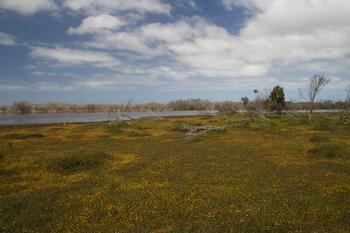 |
When he lines up on something particularly interesting, I get to peer through the scope, and sure enough I can see the nostril hairs on some duck or other that I still can't make out with the naked eye. I wile away the rest of the time in this tranquil little spot composing flora photographs of the surrounding spring blooms. |
 |
We're barely back on the metal led road again when we see signs for the next attraction: Seal Bay, somewhat inappropriately home to a colony of sea lions. We join a guided tour to walk down to the beach where dozens of them are littered along the sand, sun-bathing. |
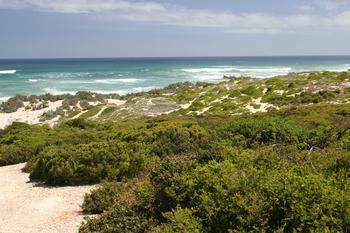 |
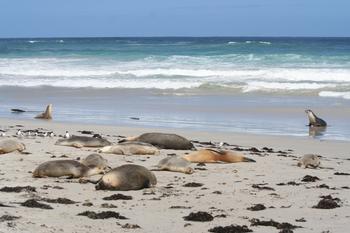 |
The guide carefully picked a path to walk in amongst them. We saw a mother come in from the sea, call once and an immediate answering cry from further up the beach. A little guy separated from the crowd and hurtled down to the surf to meet her. The guide says the mother has been out to sea for two or three days. |
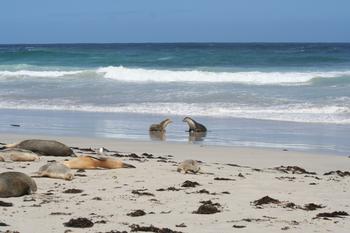 |
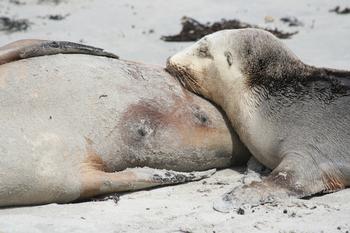 |
He's h u n g r y. Sure enough as soon as she finds a spot above the waterline she rolls over on her side and the pup makes straight for the bar. We spend perhaps half an hour wandering among them and then make our way up the boardwalk back to the visitor center. |
 |
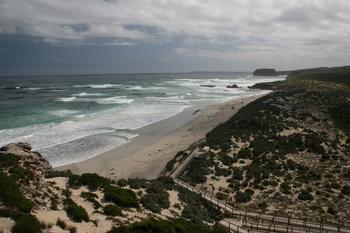 |
From there, a second path led to a lookout with a commanding view of the whole beach, including a whale skeleton which made chicken feed of the rest of the road kill in our catalog. Back in the parking lot, we can't help noticing the Sea Link bus is here. If you look in the lower right corner of this view along the sea lion beach you can make out the whale skeleton. The other lens picks out the detail. |
 |
 |
We continued west towards Flinders Chase National Park, our ultimate destination. But before we can reach it, another road-side attraction beckons: a "Koala Walk." It is extremely unassuming, and seems to be affiliated with a trailer park/camp site. But there do not seem to be any fees, and the gate is open, so we wander in. Rocks and pebbles line a path through the trees, but there's otherwise no signage. The path looks just the same as the rest of the ground in the park, so the rocks provide some comfort that we will not lose our way, which is good, because as you walk around looking straight up into the trees, it is hard to navigate at the same time. |
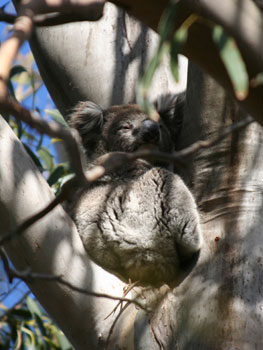 |
Naturally Wayne has spotted three or four koalas before I spot one for myself. They are mostly doing what TV has taught us to expect: sitting in the cleft of two branches. One is more energetic, and puts on a great display of roaring, head back, howling-at-the-moon style. It is surprisingly lion-like. We take a lot of pictures, trying to get something closer, or with less vegetation in the way, or with their claws out, or...

|
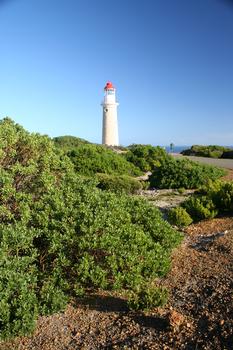 |
Finally, the entrance to Flinders Chase. We have to check in at the Visitor's Center, a) because everyone needs a permit to enter the park, and b) because this is where we need to confirm our registration for our night stop at the Cape Borda Lighthouse at the far north-western edge of the park. Hot meat pies are for sale, and are therefore purchased. Then we head south to the south-west corner and Admiral's Arch, whatever that is. Is is marked as one of the island's major attractions, and there also appears to be a seal colony there, so who are we to argue? We park the car next to the Sea Link bus and a picture-perfect lighthouse and follow the boardwalk down towards the shore line. |
 |
There is a small island off the shore, totally barren, so it is more of an enormous rock than an island. Huge ocean rollers crash into it at regular intervals, sending spray 50 feet into the air. This view alone is worth the trip, but the path continues to descend. And sure enough, as we get to sea level, we're overlooking New Zealand Seals (don't ask, I have no idea what they are doing here, so far from home) scattered in the rocks and creases, and slipping in and out of the surf. I'm running low on camera memory, and don't take as many shots as I'd like. Although this isn't the time or place, I resolve to do what I swore I wouldn't be tempted by: culling shots as I go along. |
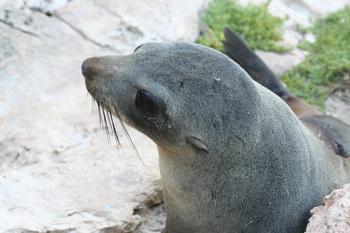 |
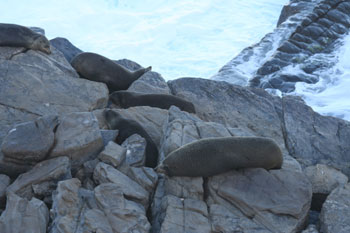 |
 |
Wayne finds a Brit to talk plantaginates with, and to compare the size of their scopes. The path continues down and around the cliff, so for completeness we head on down, and finally come face to face with the Admiral's Arch, and finally understand what the fuss is about. It is a 50 foot hole in the cliff that runs clean through to the other side—forming an arch no less. The seals are here too, taking advantage of the flat floor to the arch for easy access to the water. |
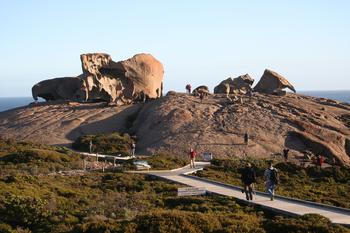 |
 |
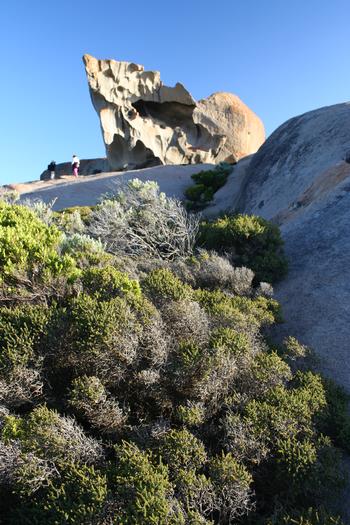 |
By now the sun is dropping, and this is a perfect time to hit the Remarkable Rocks, which are supposed to be at their best at sun up and sun down. There's not much to say, you have to see them. They are, to coin a phrase, remarkable. A jumble of 30ft high pebbles, some wind- and water-sculpted into wild curves and creases, others smooth and round as eggs, set on a plinth of rock that slopes away into an eventually vertical drop to the sea. In typical Oz you-are-responsible-for-your-own-stupidity style, there is a map showing the rocks and a line between them and the sea, showing the recommended perimeter of safe passage, but the line is not present on the rock itself. You must figure that out for yourself. Sea Link has let too many people loose, and I wait a long time to get each shot with as few people as possible in it, and there's always some moron who needs to climb that which simply needs to be viewed from a distance. But this turns out to be if not world-renowned (we'd never heard of them) but certainly an Australia-wide attraction. With some cause. So we should expect a crowd, and be grateful that being spring, it was as small as it was.
We've had such a great day, our luck has been so good, and our timing has been so perfect, that when we see that the platypus ponds are on our way home, and it is now seriously into dusk—again, perfect timing—it is clear that we have no choice but to make one last stop.
|
So it was around 7.00pm when we pulled into the Platypus Ponds parking lot, which is mercifully free of the Sea Link bus. Apart from the sandy soil, the abundant Eucalypt and (we think) Myrtle—it's like Juniper—and the kangaroos that bounce ahead of us down the wide track like dogs on a walk, it's just like a New England wetland. After about 100 yards the wide track ends at a T-junction, where the much narrower circular route around the ponds begins and ends (if a circular something can begin or end). The map shows that the path is littered with turn offs to viewing areas. We decided on a strategy: we'll just pick one, and stay there until it gets too dark to see anything.
The sign warns folks about how shy and elusive the platypi are, and that one needs to be quiet and still. And patient. The rental car folks had warned us that a) this was the wrong season b) the water level was too high c) it had been perhaps three years since they'd heard of anyone seeing anything. But what the hell—we were in the right place at the right time, we had nothing else to do, and this was our last chance.
The path was very quiet, but very beautiful. Lots of boardwalk and little bridges across the streams. I say stream, but the black water showed no current. It was still as night. Speaking of which, it was getting seriously dark. As we crept out to the first viewing area, we found two people already sitting on the dock. We tip-toed away to the next one. It was a perfect choice, overlooking a half acre pond. The water was inky black in the dusk, but the reflecting sky meant we'd notice a pin drop on the mirror surface. We stood and waited. Not a movement, not a sound, not a whisper. The other folks couldn't have been more than 50 feet away, and we heard nothing of them either. Twenty minutes went by, and the light was almost gone. Good job we brought our headlights for the return trip. I figure in about 10 more minutes it will be completely dark. Five more minutes go by.
Suddenly, off to our left, there's a plash, like a hand pulled quickly through the bath water. We both turn, and there is clearly something low in the water, steaming straight towards us. Wayne grabs his headlight and shines it on the little swimmer. It is clearly, without question, a platypus. We can see his bill and his little beady eye, and the flat tail. He swims right across the stage in front of us. It takes about ten seconds, and it is gone. You can't make noise, so we were dancing silent gigs and faking high fives. We couldn't believe our eyes, and our luck. There was nothing to do after that but return to the car and crack the rum we were carrying. Wayne skips. Quietly. He's even prepared to admit it beats (some of) his bird sighting successes. High praise indeed. Obviously there are no pictures.
After a couple of rum shots there is an hour's night drive on a washboard dirt road to Cape Borda lighthouse where we've rented the cheapest accommodation of the trip—a hut for A$18.00—on the far north western corner of the park and the island.
It's dark, it has been a very long day, and there are more buildings than we were expecting at the lighthouse. But we pick the one that looks most like a guest house, and sure enough, as we'd been led to believe, the key is in the lock. We stumble inside will all our equipment, pour some more rums and take a look around. All appears in order, except that the linen we'd ordered, which had doubled the price of the hut, was not in evidence, and the only cupboard that looked promising was also the only one that was locked. I was shattered, and went to bed anyway. Wayne stayed up a while to work on his notes. I was already asleep when there is a knock at the door. I hear Wayne answer it "G'day mates, everything in order?" Wayne says "well no actually, the linen we ordered isn't here." "Ah says the warden. That's on account of the fact this this isn't the hut you reserved. This is $70 hut, " (ours was $17) "but no worries, the people who rented this one are not showing up, so stay where you are." |
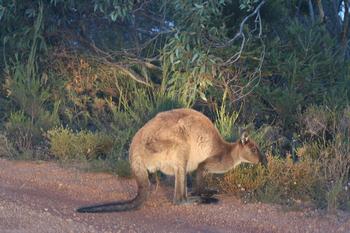 |
|
















